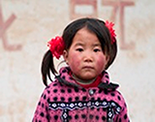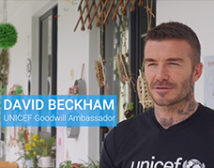Beijing, 17 September 2015 – Thousands of babies have been born free of the HIV virus thanks to effective interventions provided by the Government of China with technical support from UN agencies, according to a new Progress Report released this week on Progress report on China National Prevention of Mother-to-Child Transmission of HIV, Syphilis & Hepatitis B Programme, compiled by the National Health and Family Planning Commission.
The Progress report, one of several under discussion by senior government representatives and experts from 20 countries, highlights that HIV infection rates among infants born to HIV-positive women has witnessed a sharp decline of more than 80 per cent in China in the past decade.
The findings, shared at the 10th Asia-Pacific United Nations Elimination of Parent-to-Child Transmission of HIV and Syphilis Task Force meeting in Beijing this week, demonstrated the Government's commitment to expand services to women in need and also contribute to global targets to eliminate new paediatric infections by 2030. The meeting represents a moment of reflection in a regional effort to eliminate parent-to-child transmission of HIV and syphilis, including improved detection rates and strengthened adherence to HIV treatment programmes.
In China, prevention efforts have resulted in drastic reductions in mother to child transmission, from 34.8 per cent before the start of the PPTCT programme to 6.1 per cent in 2014. Furthermore, the percentage of parent-to-child transmission among all new HIV infections also declined from 1.6 per cent in 2005 to 1.1 per cent in 2014.
In 2014 alone, through the country's prevention of mother to child transmission of HIV, syphilis and hepatitis B (PMTCT) programme, 1,240 Chinese children who would otherwise have been infected with HIV were born free of the virus as a result of the intervention. From 2005 to 2014, the proportion of HIV-positive mothers receiving antiretroviral drugs rose from 64.6 per cent to 82.6 per cent, while the proportion of children born to HIV infected women receiving the drugs climbed from 77.2 per cent to 91.7 per cent.
In 2010, the China National PMTCT Programme expanded from providing preventive services from one disease to three, and in doing so focus not just on HIV but also on syphilis and Hepatitis B, communicable diseases that can be passed through pregnancy and birth from mother to child. Earlier this year, the Government of China announced that the country has scaled up prevention services nationally.
“We welcome the significant progress made by the Government of China to not just scale up services across the country, but also integrate prevention of all these diseases into their existing maternal and new born package of care services,” said Rana Flowers, UNICEF's Representative to China. “Experience globally has demonstrated that we can eliminate transmission of these potential lethal diseases for new born babies, as well as keep mothers alive and healthy if we make the right investments in strong public health care systems that reach women and children, especially the most disadvantaged families.”
HIV transmission to children can happen during pregnancy, at birth or through breastfeeding. Globally there is up to a 30 per cent chance of HIV positive women transmitting HIV to their baby if untreated - about half of all HIV-positive babies will die before the age of two.
Syphilis can cause serious complications for pregnant women and unborn children, including early foetal loss, stillbirth, neonatal death, low birth weight, congenital malformation and serious neonatal infections. Simple cost-effective screening during pregnancy followed by effective treatment options like penicillin can dramatically reduce the risk of these complications.
Hepatitis B can lead to acute illness and/or chronic disease, which puts people at risk of developing life-threatening liver cancer or cirrhosis of the liver.
“The Government of China has demonstrated visionary leadership in responding to some of the biggest public health challenges of our times,” said Catherine Sozi, UNAIDS Country Representative. “But we can only protect mothers and their children if we move beyond the health sector. We will only reach an AIDS-free generation and eliminate the transmission of syphilis and other diseases from mother to child if we overcome the stigma and discrimination which women often face. Every woman and every child has the right to life-saving treatment.”
Despite the progress, the sheer size of the population, regional disparity and migration all add to the challenges China faces to achieving an AIDS free generation, and underline the importance of expanding services to the hardest-to-reach, socially excluded and vulnerable populations as well address stigma and discrimination that continues to hamper efforts to reach high risk populations.
“While important progress has been made on reducing parent-to-child transmission of diseases like HIV and Hepatitis B in China, babies are still being born today in China and elsewhere who are infected with these diseases. Every new infection is one infection too many. We know what needs to be done to prevent all of these diseases – and the necessary interventions are often very simple. Let's focus our efforts on how to make that happen,” said Dr Bernhard Schwartländer, WHO Representative in China.
The first prevention of parent-to-child transmission (PPTCT) pilot programme was launched in Shangcai County, Henan Province in 2001, by the Government of China with support from UNICEF. The success of the initial pilot sites, where HIV prevalence was higher, demonstrated that the combination of testing and medication as well as provision of high-quality maternal and child health services, community based support and peer counselling to HIV positive mothers, who often faced high levels of discrimination, was critical in lowering HIV infection rates.
About UNICEF
UNICEF promotes the rights and wellbeing of every child, in everything we do. Together with our partners, we work in 190 countries and territories to translate that commitment into practical action, focusing special effort on reaching the most vulnerable and excluded children, to the benefit of all children, everywhere.
About UNAIDS
The Joint United Nations Programme on HIV/AIDS (UNAIDS) leads and inspires the world to achieve its shared vision of zero new HIV infections, zero discrimination and zero AIDS-related deaths. UNAIDS unites the efforts of 11 UN organizations—UNHCR, UNICEF, WFP, UNDP, UNFPA, UNODC, UN Women, ILO, UNESCO, WHO and the World Bank—and works closely with global and national partners to maximize results for the AIDS response. Learn more at unaids.org.
About WHO
WHO is the directing and coordinating authority on international health within the United Nations' system. We do this by providing leadership on matters critical to health and engaging in partnerships where joint action is needed; shaping the research agenda and stimulating the generation, translation and dissemination of valuable knowledge; setting norms and standards and promoting and monitoring their implementation; articulating ethical and evidence-based policy options; providing technical support, catalysing change, and building sustainable institutional capacity; and monitoring the health situation and assessing health trends. For more information about WHO in the Western Pacific Region, visit: http://www.wpro.who.int/about/en/
Visit UNICEF China website: www.unicef.cn
Follow us: Sina Weibo: http://weibo.com/unicefchina Tecent Weibo http://t.qq.com/unicef
Wechat: unicefchina

For further information, please contact:
Shantha Bloemen, UNICEF China, +8610 85312610, sbloemen@unicef.org or Liu Li, UNICEF China, +8610 85312612, liliu@unicef.org





























